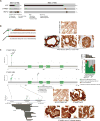Clinical Sequencing Defines the Genomic Landscape of Metastatic Colorectal Cancer
- PMID: 29316426
- PMCID: PMC5765991
- DOI: 10.1016/j.ccell.2017.12.004
Clinical Sequencing Defines the Genomic Landscape of Metastatic Colorectal Cancer
Abstract
Metastatic colorectal cancers (mCRCs) are clinically heterogeneous, but the genomic basis of this variability remains poorly understood. We performed prospective targeted sequencing of 1,134 CRCs. We identified splice alterations in intronic regions of APC and large in-frame deletions in CTNNB1, increasing oncogenic WNT pathway alterations to 96% of CRCs. Right-sided primary site in microsatellite stable mCRC was associated with shorter survival, older age at diagnosis, increased mutations, and enrichment of oncogenic alterations in KRAS, BRAF, PIK3CA, AKT1, RNF43, and SMAD4 compared with left-sided primaries. Left-sided tumors frequently had no identifiable genetic alteration in mitogenic signaling, but exhibited higher mitogenic ligand expression. Our results suggest different pathways to tumorigenesis in right- and left-sided microsatellite stable CRC that may underlie clinical differences.
Keywords: APC; CTNNB1; colorectal cancer; integrative genomics analysis; intronic alterations; location; prognosis.
Copyright © 2017 Elsevier Inc. All rights reserved.
Figures





Comment in
-
Characterizing the Killer Colorectal Carcinomas.Cancer Cell. 2018 Jan 8;33(1):7-9. doi: 10.1016/j.ccell.2017.12.010. Cancer Cell. 2018. PMID: 29316434
-
Colorectal cancer: Genomic landscape of mCRC revealed.Nat Rev Clin Oncol. 2018 Mar;15(3):134-135. doi: 10.1038/nrclinonc.2018.10. Epub 2018 Jan 23. Nat Rev Clin Oncol. 2018. PMID: 29358779 No abstract available.
References
Publication types
MeSH terms
Substances
Grants and funding
LinkOut - more resources
Full Text Sources
Other Literature Sources
Medical
Molecular Biology Databases
Research Materials
Miscellaneous

